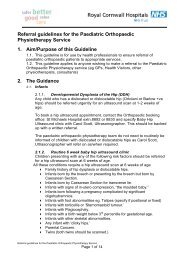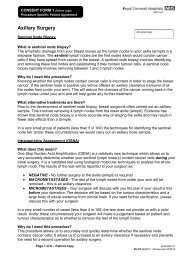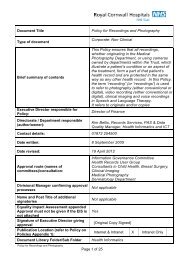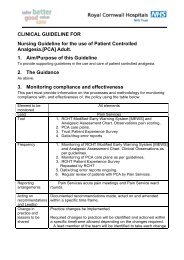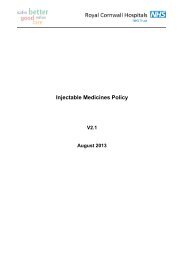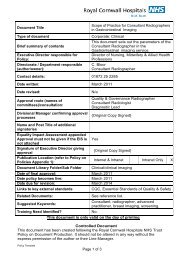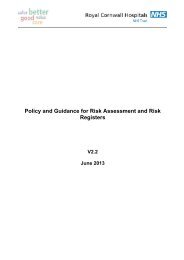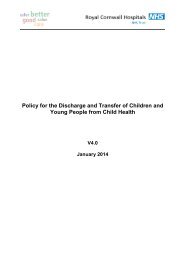Catheterisation in Adults - the Royal Cornwall Hospitals Trust ...
Catheterisation in Adults - the Royal Cornwall Hospitals Trust ...
Catheterisation in Adults - the Royal Cornwall Hospitals Trust ...
Create successful ePaper yourself
Turn your PDF publications into a flip-book with our unique Google optimized e-Paper software.
4.21 FluidsUnless restricted for medical reasons, an adequate fluid <strong>in</strong>take should be encouraged per 24hours, as this ma<strong>in</strong>ta<strong>in</strong>s a flow of uri ne through <strong>the</strong> bladder and helps prevent constipation.There is no evidence of long-term benefit or ap propriate dosage of cranberry juice with useof ca<strong>the</strong>ters. Fur<strong>the</strong>rmore, caution should be exercised for those patients tak<strong>in</strong>g warfar<strong>in</strong>(Suvarna et al 2003). However, citrate-based d r<strong>in</strong>ks are recommended as <strong>the</strong>se have beenfound to positively affect <strong>the</strong> pH of <strong>the</strong> ur<strong>in</strong>e.4.22 L<strong>in</strong>k dra<strong>in</strong>age systemThe dra<strong>in</strong>age bag sho uld not be disconnected from <strong>the</strong> ca<strong>the</strong>ter, b ut <strong>the</strong> night bag isconnected to <strong>the</strong> dra<strong>in</strong>age tap. Patients <strong>in</strong> Care Homes (both residential and those thatprovide nurs<strong>in</strong>g) and <strong>in</strong> hospital must have a n ew s<strong>in</strong>gle-use night dra<strong>in</strong>age bag every nightwith disposal of <strong>the</strong> used bag. T here is m<strong>in</strong>imal research regard<strong>in</strong>g <strong>the</strong> issues on <strong>in</strong>fectioncontrol for patients <strong>in</strong> <strong>the</strong>ir own homes who reuse <strong>the</strong>ir night bags for 5 – 7 nights (<strong>the</strong>y areencouraged to r<strong>in</strong>se through with f reshly drawn tap water and left to dra<strong>in</strong>). Se lf-car<strong>in</strong>gpatients are more suite d to dra<strong>in</strong>able bags than those who require carers to manage <strong>the</strong>ca<strong>the</strong>ter system. However, should care needs change and <strong>the</strong> patient is no longer able toself-manage <strong>the</strong>ir ca<strong>the</strong>ter system, <strong>the</strong>n switchi ng to s<strong>in</strong>gle-use night dra<strong>in</strong>age bags will benecessary.4.23 Storage of ca<strong>the</strong>tersExcess quantities of stored ca<strong>the</strong>ters can <strong>in</strong> crease <strong>the</strong> risk of damage to <strong>the</strong> product orpass<strong>in</strong>g <strong>the</strong> expiry date. For exa mple, latex ca<strong>the</strong>ters h arden when <strong>the</strong>y are old and if<strong>in</strong>serted after <strong>the</strong> expiry date, <strong>the</strong> risk of perforat<strong>in</strong>g <strong>the</strong> bladder is <strong>in</strong>creased.It is important that equipment is available withi n <strong>the</strong> patient’s home, which will ensure that<strong>the</strong> correct ca<strong>the</strong>ter is used for <strong>in</strong>dividual needs. In <strong>the</strong> community, it is recommended thatpractitioners document that new stock has been ordered to replace what has been used. In<strong>the</strong> hospital environment, safe storage and stock rotation of <strong>the</strong> ca<strong>the</strong>ters is expected.4.24 Ca<strong>the</strong>ter-lifeThere are two dist<strong>in</strong>ct groups of patients to describe a ca<strong>the</strong>ter-life, that is, those who wear aca<strong>the</strong>ter that blocks an d those tha t don’t (non -block<strong>in</strong>g). The ma<strong>in</strong> cause of a blockedca<strong>the</strong>ter is encrustation. Non-block<strong>in</strong>g ca<strong>the</strong>ters are those which ma<strong>in</strong>ta<strong>in</strong> <strong>the</strong> patency of <strong>the</strong>ca<strong>the</strong>ter for <strong>the</strong> duration of <strong>the</strong> ca<strong>the</strong>ter-life expectancy, such as 12 weeks for a long-termca<strong>the</strong>ter.Encrustations usually form on <strong>the</strong> tip of <strong>the</strong> ca<strong>the</strong>ter, <strong>the</strong> balloon area th at is ba<strong>the</strong>d <strong>in</strong> ur<strong>in</strong>eand <strong>the</strong> lumen of <strong>the</strong> ca<strong>the</strong>ter. They are not usually found on <strong>the</strong> side of <strong>the</strong> balloon that isaga<strong>in</strong>st <strong>the</strong> bladder mucosa or <strong>the</strong> surface that is <strong>in</strong> contact with <strong>the</strong> urethra.The duration of time that <strong>the</strong> ca<strong>the</strong>ter can be left <strong>in</strong> place before it becomes blocked, leaks oris pulled o ut by <strong>the</strong> patient is refe rred to as t he ca<strong>the</strong>ter-life. Monit or<strong>in</strong>g this w ill helpeffective plann<strong>in</strong>g to reduce <strong>the</strong> risk of blockage as opposed to crisis <strong>in</strong>tervention.Persistent blockage and o<strong>the</strong>r complications such as r ecurrent symptomatic CAUTI orhaematuria, may require <strong>in</strong>vestigation and refe rral for <strong>in</strong>vestigation. Cystoscopy should beconsidered to rule out t he presence of bladder stones. Th ere is no evidence that send<strong>in</strong>gca<strong>the</strong>ter tips to Cl<strong>in</strong>ical Microbiology is beneficial.10 of 16




